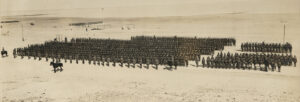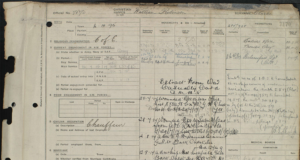We publish a wide range of research guides that offer an overview of the records we have and how best to search for them. The best starting point for searching those who served in the British Armed Forces in the First World War would be here. However, there are some particular aspects of Caribbean participation in the conflict that might affect how you search.
Army
The British Army had had a substantial presence in the Caribbean from the 16th century onwards, involved in creating and defending the British Empire, and British commercial interests. Prior to abolition in the 19th century this had included troops made up of enslaved Africans. By the beginning of the 20th century there were three units based in the West Indies. The West India Regiment (WIR) was mostly drawn from African and Asian Caribbean communities with a ‘white’ officer class was the largest. There were also smaller ‘militia’ including the Bermuda Volunteer Rifle Corps and the Bermuda Garrison Artillery. These, by contrast, were exclusively ‘white’ troops.
At the outbreak of the First World War, the War Office decided that colonial ‘coloured’ troops would not fight against ‘white’ Europeans, and this shaped the ways in which the troops were deployed. The WIR fought in West Africa, East Africa and Palestine. The ‘white’ Bermudan militia largely served on the Western Front. Additionally, at the outbreak of the First World War, many West Indians travelled to the UK to enlist and a new regiment, the British West Indies Regiment (BWIR) was formed from more than 15,000 volunteers. The BWIR served on the Western Front, in the Middle East, and in East Africa. When in Europe and the Middle East they were usually put in non-combatant (though often no less dangerous) roles.

The 1st Batallion, British West Indies Regiment, in Egypt in May 1916 (catalogue reference CO 1069/369)
A colour bar was in force that meant that commissioned officers were required to be ‘pure-European’, although this rule was not always enforced and temporary commissions were offered to black men who had the support of their commanding officer. One such man was the English professional footballer, Walter Tull, who had Barbadian heritage. He was commissioned to Second Lieutenant in the Middlesex Regiment in 1917 before being killed in action in 1918.
Most of the service records for the First World War were destroyed by fire and bomb damage to the Record Office during the Second World War. However, amongst the records that remain are some for both the West India Regiment and the British West India Regiment. The records themselves sometimes confuse these two different regiments as we will see in an example below. If you aren’t able to locate a service record, there is still a much higher chance of finding a medal record. More general advice on the records and searching is given in our guide to the records of British Army soldiers of the First World War.
Royal Navy
Like the British Army, the Royal Navy had also been present in the Caribbean over several centuries and had owned and hired enslaved people into the nineteenth century. In 1914, the Royal Navy operated a more general colour bar, such that only ‘white’ men could be employed as mariners, others could only serve as crew, fulfilling various service roles that maintained the functioning of a ship and supporting combat indirectly. This again, did not imply that their work was less dangerous. As early as 1 November 1914, West Indian members of the crew of HMS Good Hope died when the ship was sunk in the Battle of Coronel, off the coast of Chile. In addition, this colour bar was not always adhered to. For example, Lilian Bader has described the career of her father Marcus Bailey, born in Barbados, and living in Liverpool when he joined the Royal Navy in 1916 as an able seaman on HMS Chester.
You can look for service records for the Royal Navy during the First World War here, using names and place of birth as search terms. As with the army records, you can also search for medals awarded to members of the Royal Navy. Those who worked in ‘service’ roles, rather than combatant roles, were also eligible for medals.
RAF
The RAF was formed in 1918 by combining the Royal Flying Corps and the Royal Naval Air Service. Among those who joined each of those services were men from the Caribbean. Our guide to Royal Air Force personnel explains how to search through the records of each. The RAF, like the other armed forces, operated a colour bar in the First World War. However, here also it was relaxed in some instances and black personnel did certainly work as ground crew and fly as pilots in these services. For example, Samuel Wesley Yearwood, of Port of Spain, Trinidad, worked as an aircraft mechanic and it is known that Sergeant William Robinson Clarke of Kingston, Jamaica flew biplanes over the Western Front in the summer of 1917.

Detail from the RAF service record for Sergeant William Robinson Clarke. The larger record shows that he joined the RFC in 1915 at 18 years old, and was trained as a pilot in 1917, before being transferred into the RAF in 1918 (catalogue reference AIR 74/94).
